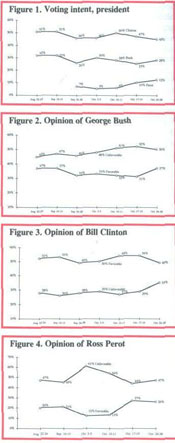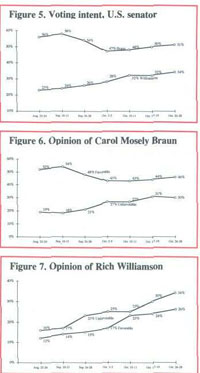The Pulse
The election results for president and U.S. senator in Illinois may indicate that the races were never in doubt. But a free-spending independent presidential candidate and an issue over investment income unreported to Medicaid authorities for the mother of the Democratic Senate candidate provided plenty of suspense until the election was finally over. The 15-point winning margin Illinois gave Bill Clinton was one of the highest in the nation. Clinton got 49 percent of the Illinois vote to 34 percent for George Bush and 17 percent for Ross Perot. And Carol Moseley Braun, the Democrat, won by a landslide in the race for U.S. Senate, beating Republican Rich Williamson 55 percent to 45 percent.
On the way to those final outcomes, Market Shares conducted nearly 8,000 telephone interviews in Illinois for the 32/January 1993/Illinois Issues Chicago Tribune, tracking shifting sentiments of those who were likely to vote in the November election. The first of seven statewide polls was done August 22-24, just after the Republican National Convention, and found the incumbent GOP president trailing Democrat Clinton by 19 percentage points. (See figure 1). The tone set by the Christian Coalition at the Republican Convention (anti-abortion plank and heavy emphasis on "family values") also left Bush out of the mainstream for most Illinois voters. Thirty-six percent of voters chose Bush over Clinton as being "too closely tied to narrow interest groups, not mainstream Americans." By 40 percent to 25 percent, Illinois voters chose Clinton over Bush on "best representing your views on abortion." The same poll showed that a majority of Illinois voters, 53 percent, wants legalized abortion with some restrictions. Only 12 percent want to see abortion illegal regardless of circumstances as called for by the Republican party platform, while 27 percent said abortion should be legal without restrictions. (See table.) Throughout most of the campaign, voters in Illinois held opposite opinions of Clinton and Bush. (See figures 2 and 3.) About half were favorable toward Clinton and unfavorable toward Bush; about 30 percent had an unfavorable opinion of Clinton and about the same number were favorable toward Bush. About half of all voters (49 percent) thought it was Clinton who was addressing the issues which really mattered most to them, while one-fifth (21percent) thought it was Bush. (See table.) More believed Clinton rather than Bush could solve economic problems, 37 percent to 19 percent. Those opinions had much to do with Bush's lack of performance on the economy since in the September 26-28 poll only 39 percent of Clinton's voters said they were voting for him because they knew he would do a good job as president, while 44 percent said they were mainly voting against Bush.
Both candidates showed some weakness on the much-discussed character issue. (See table.) While Bush was perceived to have a "higher standard of conduct and ethics" than Clinton, 39 percent to 28 percent, voters thought Bush more than Clinton "would promise anything to get elected," 33 percent to 17 percent. There was also no clear winner on "someone you admire and respect," "most qualified" or "trust him more to run the country."
January 1993/Illinois Issues/33 The Pulse
had, but the year was 1980, long before his popularity plummeted, including within the Chicago black community). The October 3-5 poll was conducted just after an event which was far more damaging to her campaign. A Chicago television investigative unit found that Braun's mother had received $28,700 in investment income while receiving full Medicaid coverage as a nursing home resident. Her lead dropped from 33 points in early September to 16 points by October 10-11 when the contest became even in suburban Cook County and the collar counties. By October 17-19, 41 percent of voters still were not satisfied with her explanation of the matter. Williamson was relatively unknown at the outset of the campaign. A Kenilworth attorney who had served in the Reagan administration, he was known only by 50 percent of the voters in the August 22-24 poll. By the final poll, he was known to 84 percent of the voters. As is often the case when an unknown candidate runs a predominately negative campaign, Williamson's favorable opinion increased during later polls, but his unfavorable rating was always higher. (See figure 7.) In each of the tracking polls, Braun held a much stronger lead among women than among men. Exit poll findings, reported by the Chicago Tribune, showed Braun won the female vote, 58 percent to Williamson's 42 percent, and she also won the male vote, but with a narrower margin, 51 percent to Williamson's 49 percent. Was this truly the year of the woman? The September 10-13 poll found that if the choice were between a man and woman and both candidates were equally qualified, 26 percent of the voters would vote for the woman and only 8 percent for the man. Among women voters presented with the same choice, 34 percent would vote for the woman. Nick Panagakis is president of Market Shares Corporation, a marketing and public opinion research firm headquartered in Mount Prospect. Panagakis, a member of the National Council on Public Polls, is best known for preelection and exit polls conducted for the news media in Illinois, Missouri and Wisconsin.
34/January 1993/Illinois Issues
|
|||||||||||||||||||||||||||||||||||||||||||||||||||||||||||||||||||||||||||||||||||||||||||||||||||||||||||||||||||||||||||||||||||||||||||||||||||||||||||||||||||


